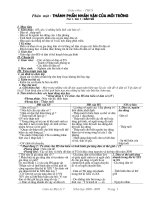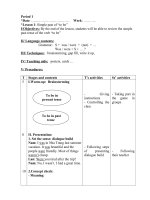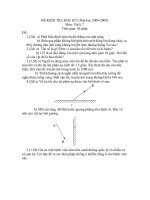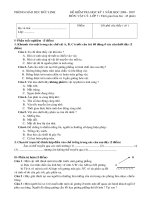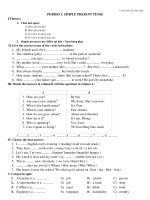GA TC 7 HKI
Bạn đang xem bản rút gọn của tài liệu. Xem và tải ngay bản đầy đủ của tài liệu tại đây (185.45 KB, 20 trang )
Period 1
*Date: …………………………… Week: ………..
*Lesson 1: Simple present tense
I/Objectives: By the end of the lesson, students will be able to review the simple
present tense of the verb “to be” and the auxiliary verbs
II/ Language contents:
Grammar: S + am/is/are + (not) + …
S + V-s/es / S + do/does + not + V
III/ Techniques: brainstorming, gap fill, write it up,
IV/ Teaching aids: posters, cards …
V/ Procedures:
T Stages and contents T’s activities Ss’ activities
5
8
I.Warm-up: Brainstorming
is am
are
go buy read
come
take cook
II. Presentation:
1. Set the sense: dialogue build
Nam: I am a student.
I go to school every morning.
Lan: Do you live in a city?
Nam: No, I don’t. I live in the country
Lan: Does your sister live in the
country?
Nam: Yes, she does. She lives in the
country, too
- Giving
instructions
- Controlling the
class
- Following steps
of presenting
dialogue build
- Taking part in
the game
- Following
their teacher
To be
Verbs
T Stages and contents T’s activities Ss’ activities
1
0
1
0
1
0
2
2.Concept check:
- Meaning:
- Form:
S + am/is/are + (not)
S + V-s/es
S + do/does + not + V
This tense usually goes with: every,
always, sometimes, often, usually,
occasionally, and seldom.
III. Practice:
1.Supply the correct verb form:
a. She often (watch) TV at night.
b. They (go) to school every day.
c. I (wash) my clothes every Sunday.
d. The director always (return) home
late.
e. Mary seldom (do) homework.
f. It (not rain) in the rainy season
2. Change into negative and
interrogative forms:
a. They are students.
b. The sun rises in the West.
c. He always comes to class on time.
d. She does homework every day.
e. My uncle drives a bus.
f. My parents often listen to music at
night.
g. Lan usually brushes her teeth after
meals.
IV. Homework:
Write things you do everyday using
simple present tense
- Asking students
some questions to
review the form,
the use, and the
adverbs that
usually go with
this tense.
- Controlling the
class
- Sticking the
poster on the
board
-Running through
- Asking sts to do
exercises
- Controlling the
class
-Getting feedback
- Sticking the
poster on the
board
-Running through
- Asking sts to do
exercises
- Controlling the
class
-Getting feedback
- Giving the task
at home
- Answering the
questions to give
the form, the use,
and the adverbs
that usually go
with this tense.
- Copying to
their notebook
- Looking at the
poster
- Listening to
their teacher
- Giving the
correct form of
the verbs
- Comparing
- Giving the
answers
- Looking at the
poster
- Listening to
their teacher
- Changing into
negative and
interrogative
form
- Comparing
- Giving the
answers
- Listening and
copying the task
Period 2
*Date: …………………………… Week: ………..
*Lesson 2: Simple future tense
I/Objectives: By the end of the lesson, students will be able to get use to the simple
future tense
II/ Language contents:
Grammar: S + will + V + …
S + will + not + V + …
Will + S + V + …?
III/ Techniques: dialogue build, gap fill, write it up, …
IV/ Teaching aids : posters, cards, …
V/ Procedures:
T Stages and contents T’s activities Ss’ activities
7
5
8
I.Warm-up: Revision
Changing into negative and
interrogative forms
1. He is a student.
2. Nam and Lan are students.
3. She goes to work every afternoon.
4. Minh does his homework at night.
5. My sisters play piano very well.
II. Presentation:
1. Set the sense: dialogue build
Hoa: What will you do this weekend?
Nam: I will go to the countryside.
2.Concept check:
- Meaning:
- Form:
S + will + V + …
S + will + not + V + …
Will + S + V + …?
- Signs: tomorrow, next, in + khoảng
thời gian trong tương lai, tonight, …
- Giving
instructions
- Controlling the
class
- Following steps
of presenting
dialogue build
- Asking students
some questions to
review the form,
the use, and the
adverbs that
usually go with
this tense.
- Controlling the
class
- Doing the
exercise
- Giving the
answers
- Following
their teacher
- Answering the
questions to
give the form,
the use, and the
adverbs that
usually go with
this tense.
- Copying to
their notebook
T Stages and contents T’s activities Ss’ activities
12
11
2
III. Practice:
1.Supply the correct verb form:
a. My father (go) to Hanoi next year.
b. She (come) here next week.
c. Our parents (build) a new house in
2010.
d. They (repair) this house tomorrow.
e. Lan (visit) me next week.
f. Daisy (buy) a new car in 2007.
g. My mother (go) to the market next
Sunday.
2. Change into negative and
interrogative forms:
h. Jane will be busy tomorrow
morning.
i. We will visit Huong pagoda next
week.
c . She will be 14 on her next
birthday.
k. I will come back tomorrow.
l. She will come back soon.
m. They will come here on time.
n. We will meet in front of the
theater.
IV. Homework:
Learn the lesson
- Sticking the
poster on the
board
-Running through
- Asking sts to do
exercises
- Controlling the
class
-Getting feedback
- Sticking the
poster on the
board
-Running through
- Asking sts to do
exercises
- Controlling the
class
-Getting feedback
- Giving the task
at home
- Looking at the
poster
- Listening to
their teacher
- Giving the
correct form of
the verbs
- Comparing
- Giving the
answers
- Looking at the
poster
- Listening to
their teacher
- Changing into
negative and
interrogative
forms
- Comparing
- Giving the
answers
- Listening and
copying the task
Period 3
*Date: …………………………… Week: ………..
*Lesson 3: Present progressive tense
I/Objectives: By the end of the lesson, students will be able to review the use of
the present progressive tense and its forms
II/ Language contents:
Grammar: S + am/is/are + (not) + V-ing
III/ Techniques: dialogue build, gap fill, write it up, …
IV/ Teaching aids : posters, cards, …
V/ Procedures:
T Stages and contents T’s activities Ss’ activities
5
7
8
I.Warm-up: Revision
Changing into negative and
interrogative forms:
1. The sun sets in the West.
2. They always comes to class on time
3. She will go to Hanoi next month.
II. Presentation:
1. Set the sense: dialogue build
Hoa: What are you doing?
Nam: I am reading books
Hoa: What is your mother doing?
Nam: She is watching TV
2.Concept check:
- Meaning:
- Form:
S + am/is/are + (not) + V-ing
- Signs: now, at the present, at the
moment, look!, listen! …
- Giving
instructions
- Controlling the
class
- Following steps
of presenting
dialogue build
- Asking students
some questions to
review the form,
the use, and the
adverbs that
usually go with
this tense.
- Controlling the
class
- Doing the
exercise
- Giving the
answers
- Following
their teacher
- Answering the
questions to
give the form,
the use, and the
adverbs that
usually go with
this tense.
- Copying to
their notebook
T Stages and contents T’s activities Ss’ activities
12
11
2
III. Practice:
1.Supply the correct verb form:
a. Goodbye! I (leave) now
b. Look! She (cross) the road.
c. The students (do) their exercises at
the present.
d. She (sing) a song at the moment.
e. What he (do) at the moment?
f. They (study) English at the
present.
g. He (not walk) now.
2. Change into negative and
interrogative forms:
a. He is teaching English.
b. She is washing her clothes.
c. They are cleaning the street.
d. I am writing a letter.
e. Peter is singing an English song.
f. Lan is listening to music.
g. Nam is walking to school.
IV. Homework:
Learn the lesson
- Sticking the
poster on the
board
-Running through
- Asking sets to
do exercises
- Controlling the
class
-Getting feedback
- Sticking the
poster on the
board
-Running through
- Asking sets to
do exercises
- Controlling the
class
-Getting feedback
- Giving the task
at home
- Looking at the
poster
- Listening to
their teacher
- Giving the
correct form of
the verbs
- Comparing
- Giving the
answers
- Looking at the
poster
- Listening to
their teacher
- Changing into
negative and
interrogative
forms
- Comparing
- Giving the
answers
- Listening and
copying the task
Period 4
*Date: …………………………… Week: ………..
*Lesson 4: Exclamations
I/Objectives: By the end of the lesson, students will be able to use exclamations to
communicate
II/ Language contents:
Grammar: What + a/an + ad + singular countable noun !
What + adj + uncountable noun /plural noun !
III/ Techniques: brainstorming, transformation drill, write it up, …
IV/ Teaching aids : posters, cards, …
V/ Procedures:
T Stages and contents T’s activities Ss’ activities
5
5
1
0
I.Warm-up: Brainstorming
good easy
bad
long cold
II. Presentation:
1. Set the sense: dialogue build
Nam: This is my room, Lan.
Lan: Oh, What a beautiful house!
2.Concept check:
- Meaning:
- Form:
What+a/an+adj+singular countable N!
What + adj + uncountable noun
/plural noun !
-Use: give a complement or complaint
- Giving
instructions
- Controlling the
class
Following steps
of presenting
dialogue build
- Asking students
some questions to
check the form,
the use, and the
meaning
- Controlling the
class
- Taking part in
the game
- Following
their teacher
- Answering the
questions to
give the form,
the use, and the
meaning
- Copying to
their notebook
adjectives
T Stages and contents T’s activities Ss’ activities
13
1
0
2
III. Practice:
1. Change these sentences into
exclamations:
a. He is an intelligent boy.
b.They are lovely girls.
c. It is fresh milk.
d. It is an exciting trip.
e. They are delicious cakes.
f. They are naughty students.
g. She is a good child.
h. It is a pretty dress.
i. They are bright rooms.
j. They are beautiful flowers.
2. Write at least 5 exclamations by
your own words:
Suggested answers:
- What a beautiful day!
- What awful weather!
- What an interesting book!
- What bad persons!
- What a delicious cake!
IV. Homework:
Learn the lesson
- Sticking the
poster on the
board
-Running through
- Asking sets to
do exercises
- Controlling the
class
-Getting feedback
- Giving
instructions
- Controlling the
class
-Getting feedback
- Giving the task
at home
- Looking at the
poster
- Listening to
their teacher
- Changing the
sentences into
exclamations
- Comparing
- Giving the
answers
- Listening to
their teacher
- Making their
own sentences
using the
structure
- Comparing
- Giving the
answers
- Listening and
copying the task
